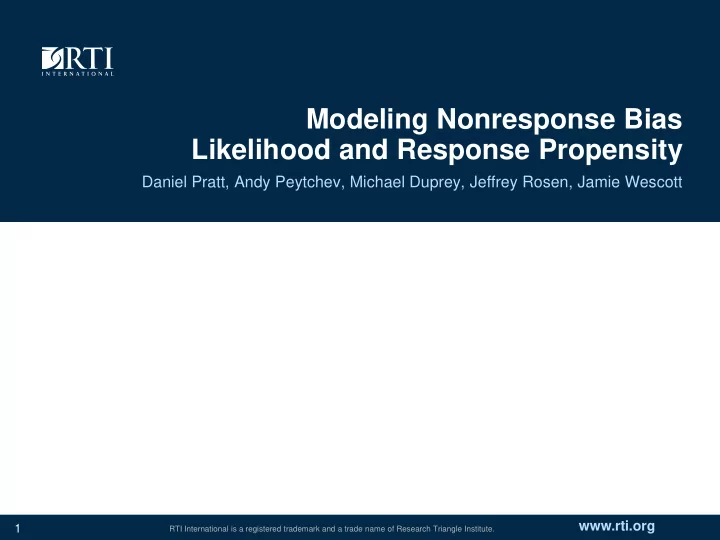

Modeling Nonresponse Bias Likelihood and Response Propensity Daniel Pratt, Andy Peytchev, Michael Duprey, Jeffrey Rosen, Jamie Wescott www.rti.org 1 RTI International is a registered trademark and a trade name of Research Triangle Institute.
Background Substantial uncertainty in survey outcomes With respect to nonresponse: Current response rates provide potential for nonresponse bias in survey estimates Pursuing the full sample with increased effort is inefficient and often infeasible 2
Approach Identify the main objective – Minimize nonresponse bias Devise multiple phases of data collection, each altering the data collection protocol – Phases should have complementary features (Groves and Heeringa, 2006) – Identify which nonresponding cases will likely lead to reduction in nonresponse bias, if interviewed Implement the protocols that should increase participation among the identified nonrespondents Evaluate results 3
Identification of Targeted Sample Cases Estimate response propensities to identify those most likely to have been excluded from the respondent pool Common approach to propensity estimation: – Assume everyone has an underlying propensity to respond – Use all available information to estimate the propensity to respond 4
Key Assumption Assumes that the estimated propensities are highly correlated with the survey variables, necessary for the approach to reduce nonresponse bias Paradata such as prior round nonresponse and needed level of effort tend to be: – Strongly correlated with nonresponse (e.g., Wagner et al., 2014) – Weakly correlated with survey measures (e.g., Wagner et al., 2014) Could explain why targeting has been ineffective (e.g., Peytchev, Riley, Rosen, Murphy, and Lindblad, 2012) 5
Proposed Approach Devise propensity models that: – Deliberately exclude strong predictors of nonresponse but are very weakly associated with survey variables of interest – Deliberately identify and select predictors that are highly correlated with the survey variables Main objective is not to identify the model that best identifies the response propensities, but to identify which nonrespondendents are likely contributing to nonresponse bias – The strong predictors of response propensity could “overwhelm” the correlates of the survey variables in the model Let’s name this model a bias likelihood model 6
High School Longitudinal Study of 2009 (HSLS:09) Nationally representative, longitudinal study of 23,000+ 9th graders in 2009 Study design: – Base year (2009) – First follow-up (2012) – 2013 Update (2013) – Second follow-up (2016) Estimate two sets of response propensities: – Response propensity model (maximize prediction of second follow- up nonresponse) – Bias likelihood model (exclude paradata that are strongly predictive of nonresponse) Re-estimate the propensities during data collection 7
Propensity Models Response Propensity Model Bias Likelihood Model Estimates unit-level response Identifies nonrespondents in probability the most underrepresented groups Covariates Covariates – Model covariates combine key variables of interest – Chosen such that (from bias likelihood model) differences should proxy and paradata nonresponse bias Dependent variable – Model excludes paradata – Current-round response Dependent variable Re-estimated prior to each – Current-round response data collection intervention Re-estimated prior to each data collection intervention 8
Does including paradata overwhelm bias likelihood model? 9
Response Propensity / Bias Likelihood – Start Interventions 10
Response Propensity / Bias Likelihood – Middle (12 weeks) 11
Response Propensity / Bias Likelihood – End (32 weeks) 12
How do the models differ in the estimation of propensities that are associated with survey variables? 13
Correlations – Start Interventions 0.6 0.5 0.4 0.3 0.2 0.1 0 Bias Likelihood Model Response Propensity Model 14
Correlations – Middle (12 weeks) 0.6 0.5 0.4 0.3 0.2 0.1 0 Bias Likelihood Model Response Propensity Model 15
Correlations – End (32 weeks) 0.6 0.5 0.4 0.3 0.2 0.1 0 Bias Likelihood Model Response Propensity Model 16
Summary and Conclusions Even when the propensity model includes the relevant variables that are associated with the variables of interest, the inclusion of paradata to maximize prediction: – Led to higher dispersion of response propensities – This produced differences between the predicted propensities of the response propensity model which included paradata and the bias likelihood model that excluded the paradata – Reduced the associations between the estimated propensities and the key survey variables We recommend going forward with the “Bias Likelihood” model approach for Responsive and Adaptive Design interventions, when using a single model 17
Next Steps Develop Bayesian approach Advantages (and possible disadvantages) of Bayesian updating of response propensity throughout data collection Evaluate impact of informative priors on bias likelihood model Integrate cost estimation 18
Thank You Daniel Pratt Education and Workforce Development RTI International djp@rti.org 19
Recommend
More recommend